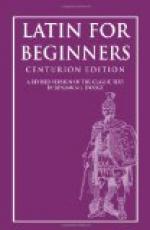What is the difference between the indicative and subjunctive in their fundamental ideas? How is purpose usually expressed in English? How is it expressed in Latin? By what words is a Latin purpose clause introduced? When should quo\ be used? What is meant by sequence of tenses? Name the primary tenses of the indicative and of the subjunctive; the secondary tenses. What Latin verbs are regularly followed by substantive clauses of purpose? What construction follows iubeo\? What construction follows verbs of fearing? How is consequence or result expressed in Latin? How is a result clause introduced? What words are often found in the principal clause foreshadowing the coming of a result clause? How may negative purpose be distinguished from negative result? What is meant by the subjunctive of characteristic or description? How are such clauses introduced? Explain the ablative absolute. Why is the ablative absolute of such frequent occurrence in Latin? Explain the predicate accusative. After what verbs are two accusatives commonly found? What do these accusatives become when the verb is passive?
[Illustration: IMPERATOR MILITES HORTATUR]
SPECIAL VOCABULARIES
The words in heavy type are used in Caesar’s “Gallic War.”
[Transcriber’s Note:
Each chapter’s Special Vocabulary was included with its chapter text in addition to its original location here. Details are given in the Transcriber’s Note at the beginning of the text. In the printed book, the vocabularies for Lesson IV and Lesson V appeared on the same page; the Footnote about conjunctions was shared by the two lists.]
LESSON IV, Sec. 39
NOUNS
dea, goddess (deity)
Dia:’na, Diana
fera\, _a wild beast_ (fierce)
La:to:’na, _Latona_
sagit’ta\, arrow
VERBS
est\, _he (she, it) is_; sunt, _they
are_
necat\, he (she, it) kills, is
killing, does kill
CONJUNCTION[A]
et\, _and_
PRONOUNS
quis\, interrog. pronoun, nom. sing.,
_who?_
cuius\ (pronounced c[oo]i’y[oo]s,
two syllables), interrog.
pronoun, gen. sing., whose?
[Footnote A: A conjunction
is a word which connects words, parts
of sentences, or sentences.]




